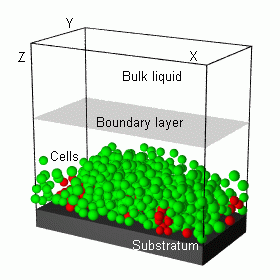
Biofilms
For more information on biofilms in general, see this page of links.
The image above shows the geometry of the biofilm, with an inert substratum at the bottom, and the bulk liquid at the top, separated from the growing biofilm by a mass transfer boundary layer at a constant height above the biofilm. The substrates diffuse downwards from the bulk liquid through the boundary layer into the biofilm. The x (width) and y (depth) dimensions are periodic.
The effect of chance on the growth of individual cells in a highly heterogenous environment is shown by an image of the clonal sectors of a biofilm, where each of the 10 ammonia oxidisers in the inoculum and their offspring is rendered in a different colour. All the nitrite oxidisers, which don't grow very much, are shown in magenta. Cells that happened to be close to others at the start of the simulation gave rise to clones that become suffocated eventually (see the red, yellow, dark blue, orange, and silver cells). In contrast, cells that were far apart from their nearest neighbours at the beginning gave rise to the largest clones. This image is also a good visualisation of what periodic boundaries are, look at how the large blue clone appears to be split into two strips, one on each side, although it is actually only one strip because the borders are wrapped around.
The mechanism of biomass spreading was found to have a marked influence on biofilm structure. The mutual shoving mechanism used in BacSim is illustrated by a movie displaying the positions of cells from time-step to time-step, starting with randomly placed cells. In this case, a very flat computational domain (0.1 µm depth) was used in order to make overlaps easier to see.
Short-term fluctuations of biofilm structure resulting from the shoving of cells from one time-step to the next, after about 30,000 min (3 weeks) of growth, are shown in this movie.
The main conclusions from this project are about the effect of the three processes diffusion-reaction, biomass spreading, and chance on the growth and shape of biofilms. Diffusion-reaction directly influences biofilm growth, while biomass spreading mechanisms directly influence biofilm shape, making shape partially independent of diffusion-reaction driven growth. Growth and shape both influence each other. Chance has a profound influence on biofilm shape and the growth of single cells or rare species, because of the high heterogeneity of substrate concentrations in the biofilm, which results from both diffusion-reaction and spreading.
Detailed documentation of this model is part of the 2001 paper in Microbiology. You can also download the source of the model, or run the simulation in your web browser, see the section on BacSim.
Compare biofilms simulated with Cristian Picioreanu's Biomass-based model with Individual-based model biofilms. The images show biofilms after 96,000 min (67 days, 9.5 weeks) of growth and the short movies visualise the first three weeks of growth, while the long movies cover the whole period. Unfortunately, the long movies are exceedingly large and only for the determined.
| Biomass-based model, biomass of species apart: | image (208k) | short movie (1.2M) | long movie (13M) |
| Biomass-based model, biomass of species coupled: | image (208k) | short movie (1.2M) | long movie (13M) |
| Biomass-based model, biomass of species mixed: | image (216k) | short movie (1.4M) | long movie (14M) |
| Individual-based model: | image (232k) | short movie (1.3M) | long movie (14M) |